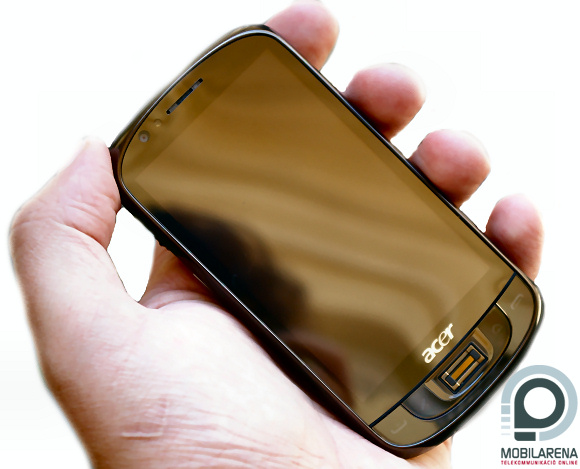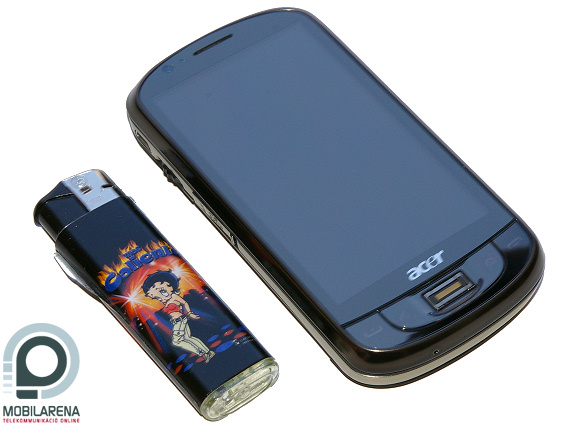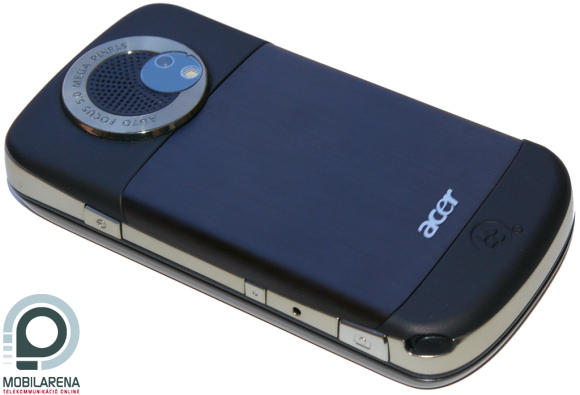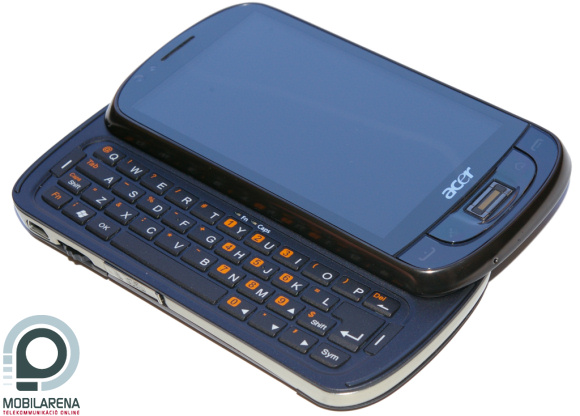Introduction, exterior
We were very happy about SpeedShop giving us Acert Tempo M900, as we could have been the first to write a review of this handset (and I mean world first), just like in many other cases. Unfortunately it turned out that although the device has been marked as being ready for review, it’s far from being in a state when one could write a real article about it, which is due to both the hand-assembled hardware and the quite beta software. This means that first we wrote a preview, in which we try to demonstrate the handset’s features in a shorter article, referring to both those that seem final and to those that need to be refined too – of course in this second case we think a bit about how can these be brought to perfection.

With the launch of M900 it has become evident that Acer would really like to have a large piece of the Windows Mobile market, and they do all they can in order to have so. The subject of our preview is evidently a rival of the HTC Touch Pro line, but not in the classical way: the new Tempo model has practically joined Touch HD and Touch Pro. This of course mean a huge all-knower handset with a QWERTY keyboard, which has all the possible features and Acer tried to include those things missing from an HTC, which is data security. This manifests in the fingerprint-reader, placed on the front panel of the 119 x 62 x 17.1 mm large handset (weighing 188 grams). We will be detailing its functionality later on.

So, M900 is a huge handset. The one I had for testing has been manually assembled, which doesn’t always mean lower quality joints, but this was the case this time. The new device, in spite of being a high-end one, cracks and creaks hard, the sliding mechanism has a play, it’s really hard to take off the battery’s cover and moist and dust fill up the display’s frame. I’m damn sure that the final version will be a higher quality one, as Acer would fail ultimately with such a crackling monster and I don’t think they want to. We’ll be having another look at the assembly quality of the final handset too, but I can already write about the quality of the materials used. The 3.8” WVGA (480 x 800 pixels) display makes up in fact the whole front panel, and it is covered with a soft, shiny plexiglass. The speaker looks a bit lame, there is a hole in the plexi and the speaker is simply placed behind it – they could really have used a grating, at least we wouldn’t have to worry about anything falling in there. On the bottom there is the fingerprint-reader I’ve already mentioned and four buttons (call accept/deny, navigation, Today), the navigation control is the fingerprint-reader, which is not as good as an optical touchpad, but it’s basically good. The back panel looks really cool, the center part, which can be taken off, is made of brushed steel, above we can see the 5 megapioxel autofocus camera, which has an impressively large circle around it. The method of taking off the back is quite interesting, as we have to push the plastic part on the bottom downwards in order to access it – we could have seen a similar panel on Samsung Innov8 recently.
On the sides there is a “chromed plastic” stripe, which has the inevitable GPS label on top, while on the bottom there is the telescopic stylus which can be taken out only with a nail. In the top left corner we can see the uncovered miniUSB connector, with the great jog-dial and the covered microSD slot under it. On the opposite side there is the power button, the camera’s shoot key and the hotkey, the reset gap being in between these last two. Usually this is missing from phone-PDAs, so it’s a great thing that we have one on M900.
The QWERTY keyboard is rather good. The main reason is that it has enough room, but it’s a fine one anyway. The buttons have a proper shape, they are made of good materials, have a perfect backlight, they only problem might be that they don’t have a proper pressure feedback, but we’ll still see on-screen if we really pressed a key, so this is no tragedy.
Hirdetés
Speed, software
The handset has Windows Mobile 6.1 as an operating system, we currently have no information about a possible upgrade to 6.5. but according to rumors there will be an option to upgrade. The handset has the same 533 MHz Samsung S3C6410 CPU that is used in the latest Acer handsets. There is 256 MB of ROM and 128 MB of RAM, which doesn’t look much, but after turning the handset on it becomes evident, as there is only 37 MB for running programs and 55 megabytes for storing data.
Although the processor theoretically supports hardware 2D and 3D acceleration, it hasn’t been very impressive. I don’t really understand Acer, E-TEN handsets with a VGA display have proven that Samsung chipsets are not enough for such a resolution, but somehow they still used the same one in M900. Unfortunately I couldn’t run speed benchamerks, as VsBenchmark doesn’t support WVGA displays and I couldn’t install Pocket PC Marck, since I couldn’t initiate an ActiveSync connection even with the cable that came with the phone. Anyway, the thing is that the handset is damn slow, which is even made worse by the fingerprint-reader’s application (which is cleverly called GoldFinger). It takes about three-four seconds for the handset to return from standby, than comes the fingerprint-reading or the password prompt, so it takes even the fastest users at least eight seconds to make the phone come alive, which is a lot. Of course we don’t necessarily have to turn on fingerprint checking when coming back from standby, we can use it elsewhere as well: there is a folder on the phone, with a freely changeable size and this needs the biometric identification to be opened. We can also protect Outlook data this way, but there’s no chance to have the handset delete information after a preset amount of errors – it would be good though, as the reader worked perfectly at me, it has never missed, which is a great result. The only positive aspect of speed can be seen when rotating the screen, as this process is fast, there are no problems with it. When rotating the main menu – opening up the keyboard – we will have a quicklaunch menu pop out with eight icons, it looks just like HTC’s solution on Touch Pro.\



The user interface didn’t change
We won’t get anything special on the software side. The nice user interface from DX960 is still here, it unfortunately still launches extremely slow, but in turn it offers a fast and easy way to use the handset. We won’t have the plethora of E-TEN software pack, as Acer has taken out lots of stuff. There is a memory optimizer application, a task manager, a profile changer, a speed dialer and that’s it. We shouldn’t panic though as we can use Application Recovery to install a name card reader, Acer Easy Keyboard, VoiceCommander and the other useful stuff. To tell the truth it’s great that these can be found only on the ROM by default, as we have to install them only if we really want to use them.
Everything else
I would have been very curious about what kind of pictures does the handset’s 5 megapixel autofocus camera make, but unfortunately M900 didn’t help me out. I managed to launch the camera’s software, but the viewfinder had a completely white image, which tells a lot about quality. Anyway, I took a picture, my hand moved accidentally, while on the second try the software hung up. Somehow the camera gives up trying, the software hangs up after focusing, even a full restart won’t help. This leaves the pure facts: Acer took care of photo settings, there is a special “intelligent” focus (this is a multi-segment solution, we can tamper with light metering and sensitivity (ISO 100 – ISO 800), and we even have face recognition. Hopefully image quality will be okay on the final edition.

I didn’t get any headset with the phone, so I couldn’t check sound quality and the FM radio. I can’t say much about uptime either, as after the problems I’ve encountered, I didn’t use the handset for a long time. Otherwise the battery has a capacity of 1530 mAh, which will hopefully be able to keep the handset online for over two days, even in spite of the large display.
Summary: M900 is a great example of why should we write a preview of a handset only if we have to say something about it (see Omnia, Innov8 and i8910 blogs). Acer’s new handset has tons of bugs, it’s not optimized, and with some exaggeration I could say that it’s unusable, even though it could make for a good handset. It has a full data transfer arsenal (HSDPA, HSUPA, WiFi, Bluetooth), it has lots of software, it has a good display, the keyboard is fine, and it even looks good. It has, however, such bugs that cannot be fixed even by a perfect software, these include the lack of a standard headset jack and the small memory capacity. We don’t know its expected price yet, but considering currently available Acer phone I’d say that it will be launched above 500 euros. I might even be competitive with a really great software, but if Acer won’t do something about it, the PDA branch could die soon. We’re waiting for the final version.
Bocha
Translated by Szaszati
The handset has been provided bySpeedShop, thanks!
Specifications
| Acer Tempo M900 | ||
 |
Technology | GSM/GPRS/EDGE 850/900/1800/1900 MHz UMTS/HSDPA 850/900/2100 MHz |
| Operating system | Windows Mobile 6.1 Professional | |
| Size | 119 x 62 x 17.1 millimeters | |
| Weight | 188 grams | |
| CPU | 533 MHz Samsung S3C6410 | |
| ROM / RAM | 256 / 128 MB | |
| Display | 3.8” diagonal, 480 x 800 pixel resolution TFT display | |
| Expandability | microSD (SDHC-compatible) | |
| WiFi | 802.11b/g | |
| Infra / Bluetooth | no / 2.0 (A2DP too) | |
| GPS receiver | 20-channel NMEA 0183 | |
| Audio | microphone, mono speaker | |
| Camera | 5 megapixels, autofocus +VGA resolution for video calls |
|
| Battery | 1530 mAh changeable Li-Ion | |
| Other | QWERTY keyboard, FM radio | |











